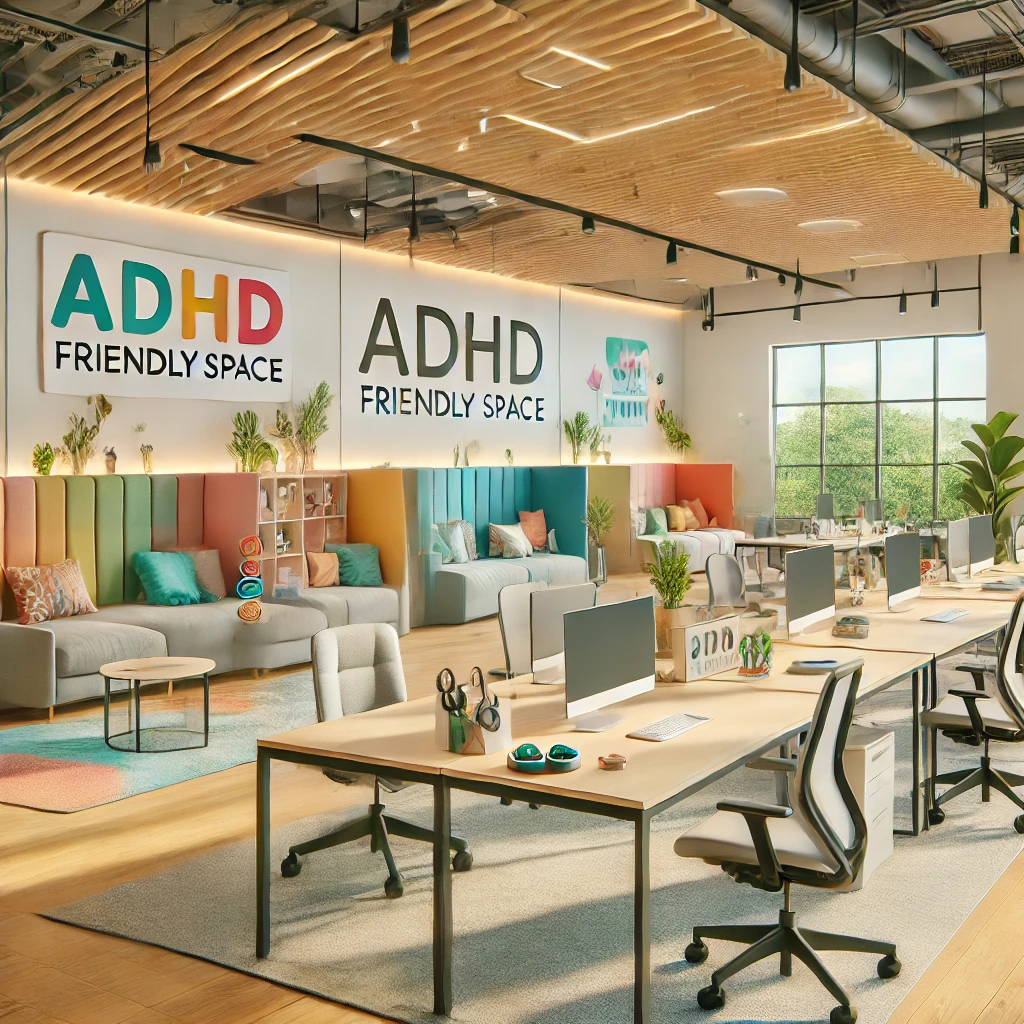Creating Adhd Friendly Workplaces for Women
Empowering Focus, Flexibility, and Growth

In my work with women in Charlotte, NC, I've witnessed the critical need for ADHD-friendly workplaces. While discussions on neurodiversity are growing, ADHD remains misunderstood and often overlooked. This lack of awareness creates workplace challenges for those affected. However, simple adjustments and shifts in perspective can help organizations better support women with ADHD. When properly accommodated, their creativity, adaptability, and problem-solving strengths can greatly benefit the workplace.
Why ADHD-Friendly Workplaces Matter for Women
Many women with ADHD face challenges including disorganization, emotional sensitivity, and difficulty focusing on repetitive tasks. These symptoms are often misinterpreted as laziness or carelessness. To compensate, they typically overexert themselves in the workplace, focusing on ill-suited tasks while their true strengths remain untapped due to fear of judgment and misunderstanding.
Masking ADHD symptoms to match colleagues' performance often leads to stress and burnout. One client experienced constant pressure to meet ill-fitting standards, leaving her exhausted and underappreciated. Workplaces unaware of these challenges inadvertently underutilize women with ADHD. However, when companies understand and accommodate ADHD in women, it transforms the work environment. Employees can flourish without conforming to neurotypical expectations, while organizations benefit from their innovative thinking and problem-solving skills.
Six Things to Focus on When Creating ADHD-Friendly Workplaces for Women:
Tailoring Workspaces for ADHD Women
Flexibility in Schedules and Deadlines
A wealth of research supports the need for flexibility for individuals with ADHD. Jansen et al. (2019) found that employees with ADHD thrive in environments that allow them to manage their time according to their natural productivity cycles. A rigid 9-to-5 schedule can be incredibly limiting, especially for someone whose focus and energy levels fluctuate throughout the day. In my experience, many women with ADHD find their most productive times don’t always match the standard workday.
For example, I worked with a client at Wells Fargo who thrived when she could shift her work hours to match her natural energy levels. When her workplace allowed her to start later and work during her peak focus periods, her productivity and job satisfaction improved dramatically. Offering flexible work hours or remote work options allows women with ADHD to optimize their focus and feel less pressured by the clock.
Structured Workflows with Autonomy
Another critical element is providing structure without micromanagement. Studies, such as those by Remington and Pellicano (2020), suggest that clear, structured tasks help reduce overwhelm in ADHD employees, but the key is also to provide autonomy. Women with ADHD often feel overwhelmed by big, undefined tasks but flourish when given clear guidelines or steps to follow. However, too much oversight can backfire, making them feel stifled.
The balance here is key: providing structured workflows, like breaking projects into smaller, manageable tasks, while giving employees the freedom to decide how they tackle them.
Minimizing Distractions
Distractions are a major hurdle for many women with ADHD, especially in open office environments. Research by Remington and Pellicano (2020) highlights how excessive noise, interruptions, and visual clutter can derail focus and productivity in ADHD employees.
In my work, I’ve heard this concern time and again—ADHD clients who struggle to regain focus after being derailed by something as small as a phone ringing, messages pinging, or a co-worker stopping by.
Creating a distraction-free environment can make all the difference. Quiet workspaces, or designated focus hours free from meetings, and working from home can make a big difference. T
These small changes towards adhd friendly workplaces help ADHD women get into their flow. One of my clients found that simply having a quieter, more controlled workspace improved her ability to focus and significantly reduced her daily stress levels.
Support for Emotional Well-Being
Emotional regulation is another challenge many ADHD women face, and it’s one that often gets overlooked in high-pressure environments like banking. Women with ADHD can be susceptible to criticism or stress, which can make managing emotions in the workplace difficult. In my experience, this is where a supportive manager makes all the difference.
A manager who understands ADHD and is willing to offer compassion and practical support can transform an employee’s work experience. For instance, one client I worked with had a manager who regularly checked in on her well-being, offered constructive feedback, and provided flexibility when needed. It is merely and attitude of kindness, and this transforms everything. This support helped her feel understood and valued, reducing the anxiety and emotional strain she had felt in previous roles.
Research supports this approach—workplaces that promote mental health resources and foster open dialogue about neurodivergence help reduce the mental strain on ADHD employees, allowing them to thrive (Remington & Pellicano, 2020). A supportive environment isn’t just pleasant to have—it’s essential for women with ADHD to flourish in the long term.
Leveraging ADHD Strengths
Now, it’s important to remember that ADHD comes with strengths, too. Sometimes, the very challenges that women with ADHD face in traditional work environments can be flipped into advantages when properly supported. Many women with ADHD excel at creative problem-solving, big-picture thinking, and adaptability. In fact, research shows that neurodiverse teams, which include individuals with ADHD, often outperform their peers in roles requiring innovation and creativity (Scott et al., 2022).
For example, I had a client who was particularly adept at navigating complex, fast-paced projects. Her ability to see connections others missed and think strategically helped her team solve problems innovatively. Once her strengths were recognized and nurtured, she became an invaluable asset to her organization.
When employers focus on leveraging these strengths—by placing ADHD women in roles that require creativity, adaptability, and quick thinking—they unlock their full potential and benefit the entire team.
Breaking Down Barriers in Hiring and Retention
Hiring processes often don’t reflect the true potential of women with ADHD. Research shows that traditional interviews, which emphasize quick thinking and memorization, can be overwhelming and might not allow ADHD candidates to fully showcase their skills (Jansen et al., 2019). This is particularly relevant in high-pressure industries like finance, where responding on the spot is often valued over thoughtful, detailed answers.
A more inclusive approach would be to give candidates questions ahead of time or allow them to provide written responses via email. This minor adjustment can make a significant difference. One of my clients, for instance, found that when she had extra time to prepare her thoughts for an interview, she could present her ideas clearly and confidently, something she struggled with in traditional interview settings. Offering this flexibility gives ADHD candidates the space to think deeply and respond at their best rather than being judged on their speed under pressure.
Another effective strategy is to incorporate task-based simulations into the hiring process. Instead of relying on a high-stress interview format, candidates can demonstrate their skills in a more relaxed, real-world scenario. This not only reduces anxiety but also allows women with ADHD to highlight their strengths, such as creative problem-solving and strategic thinking, in a more natural way.
When companies consider these approaches—providing questions in advance, offering flexible response options, and focusing on task-based assessments—they create a more level playing field for ADHD women to create adhd friendly workplaces and ensure they can fully demonstrate their capabilities.
Retention is also crucial. Providing ongoing support, such as mentorship, coaching, and regular check-ins with managers, helps ADHD women grow and thrive long-term. A workplace culture that values neurodiversity and offers resources like professional development tailored to their needs will ensure that women with ADHD stay engaged and continue contributing their talents.
Conclusion
Creating ADHD-friendly workplaces for women isn’t just about making accommodations—it’s about recognizing their strengths and fostering an environment where they can truly excel. By offering flexibility, structured workflows, distraction-free spaces, and emotional support, companies can help women with ADHD succeed and thrive.
With the right adjustments, workplaces can become spaces where ADHD women feel empowered to contribute their best, creating a more dynamic, inclusive, and innovative workforce.
An Employers Guide To ADHD in The Workplace
Creating ADHD-Friendly Workplaces for Women Resources
- Jansen, K., van Wijk, A., Reijnders, A., & Krol, N. (2019). Employment experiences of adults with ADHD. Journal of Attention Disorders, 23(9), 1045-1056. https://doi.org/10.1177/1087054719864476
- Remington, A., & Pellicano, E. (2020). Neurodiversity and workplace accommodations: Results from a study of employees with autism. Autism Research, 13(4), 637-645. https://doi.org/10.1002/aur.2263
- Scott, A. M., Wheldall, K., & Drysdale, M. (2022). Neurodiversity and creativity in the workplace: Unlocking potential. Journal of Creative Workplaces, 15(1), 45-60. https://doi.org/10.1016/j.jocreat.2022.07.003




